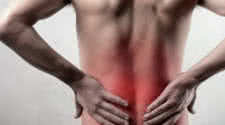How Strong Abdominals Can Affect Your Posture - Key Posture Points

Fitness and Exercises Offers Many Life-Ling Benefits to Enjoy
Even if you don't plan to bare your washboard abs. you need strong abdominal muscles for good posture. So who needs good posture?
You do not just For times when you're sucking in your gut to impress a sweet young thing hut for overall-good looks, for better
sports performance and injury prevention, and to avoid painful structural problems that ran become permanent and possibly
debilitating if not corrected in time.
How do you stand? Check the diagram "Posture Points" to determine if you're in good alignment, or if you're zigzagging toward
neck, back and knee problems.
Strong abdominal muscles are the foundation of good posture, as are your back muscles. But your abs are important because they
create intra-abdominal pressure to hold your spine stable from within, and they help 'hold the pelvis in a healthy forward tilt
(the lower section of the pelvis tilts forward). Says Southern California chiropractor Michael Warner, DC: 'The abdominal muscles
play an integral role in maintaining an adequate angle in the lumbosacral area. If the abs are weak, an increase in this angle
increases the stress to the posterior motor unit in the lumbar spine. What can happen next is that the joints and/or discs can
degenerate prematurely." Of note, too, is that strong abs can bear up to 40% of the weight on the spine. Weak abs let the potbelly
hang, provide less internal support for the lower back and allow the pelvis to tilt back (and the glutes to stick out), throwing
you out of alignment and putting a strain on your lower back.
Strong abs aren't the only thing you need for great posture, however. Notice the other points on the diagram. A strong upper back
and shoulders are especially important for bodybuilders and anyone who spends a lot of time at a desk or computer. You don't want
to end up hunched over. Lat pull-downs and rows can help counteract this, along with stretching our your shoulders and pecs.
A forward head position can lead to chronic neck pain. Neck exercises, proper posture in your work area, and perhaps an orthopedic
pillow may all help. If you have concerns about specific posture problems, see an orthopedic specialist or chiropractor.
Note the final posture points: In the standing position, your knees should be slightly flexed, never hyper extended, and your
ankles should align straight below your knees.
Ladies, beware: High heels can ruin your posture, and relying on a control-top pantyhose for a flatter tummy can leave your natural
muscular girdle weak.
POSTURE POINTS
Poor posture can hurt your health and your physique, while good posture makes you look and feel your best.Head: Craning your head forward can cause neck, shoulder and arm pain along with headaches and dizziness.
Shoulders: Rounded shoulders may cause back and neck strain.
Chest: A caved-in chest may make full expansion of the lungs difficult in cases of disease, it may affect functioning of the heart and lungs.
Abdomen / lower back: The combination of protruding abdomen and lumbar lordosis (sway back often causes lower back pain.
Hips / pelvis / thigh: A pelvic angle too far forward or back can hurt your posture. Strong abs help you maintain a healthy pelvic tilt with all posture points in alignment.
Knees: Knees should be slightly flexed and relaxed. Locking and hyper extending knees throws off overall body alignment and contributes to joint and back strain.
Ankles & feet: Proper shoes provide support and if needed, can correct inward and outward lean of ankles. Blisters caused by poor shoe fit can cause you to favor certain walking patterns that hurt your posture and performance.
Imbalanced postural lines (overall): Misalignment can cause neuritis, sciatica, fatigue, joint strain and pain throughout the body.